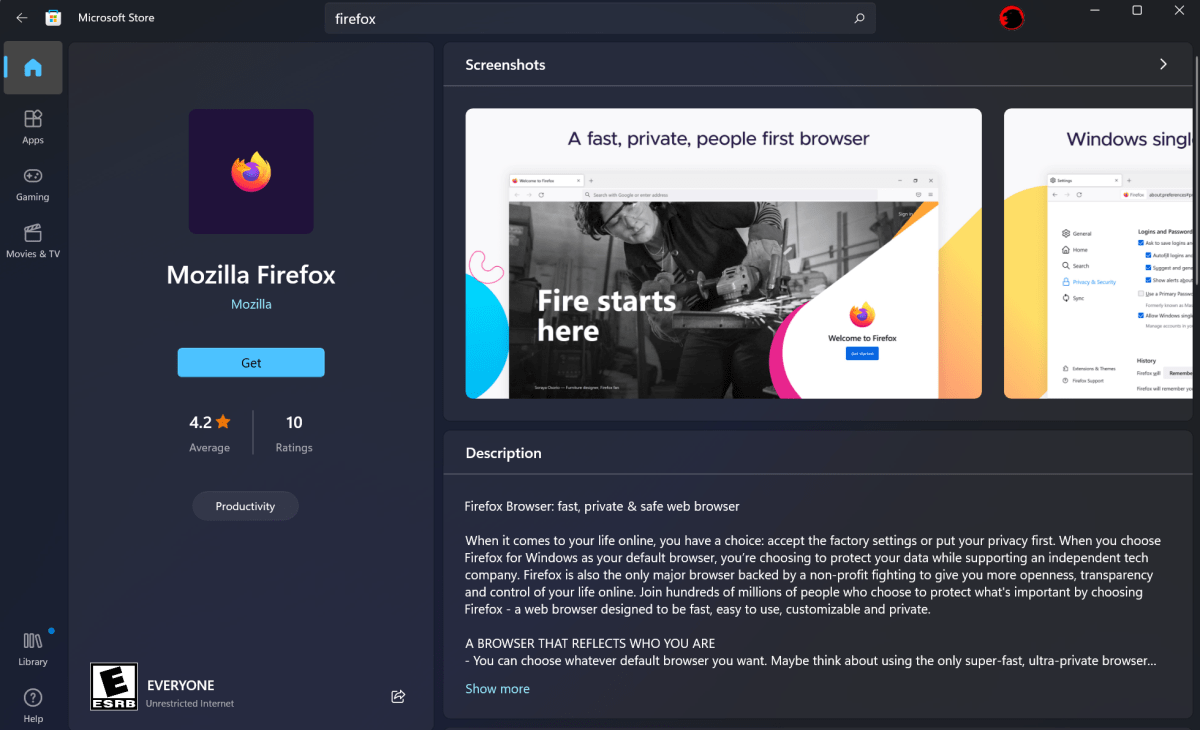 Image: Mark Hachman / IDG
Image: Mark Hachman / IDG
On Tuesday, Mozilla Firefox became the first major browser to be added to the Microsoft Store, an important addition for those hoping for more browser choice within Windows 10 and 11.
According to Mozilla, the change came as a result of Microsoft changing its policies on allowing third-party browser support. “Until recently, Microsoft’s store policies required that all web browsers use the engine that Microsoft had built into their platform, which meant we were unable to ship the Firefox you know and love in the Windows Store,” Mozilla said in a blog post.
“Now that Microsoft has changed their policies, we are finally able to ship Firefox with our industry-leading Gecko engine in the Windows Store,” Mozilla wrote. (In June, Microsoft also added Opera and Yandex to the Store as well, a Microsoft representative wrote in an email.)

Mark Hachman / IDG
Mark Hachman / IDG
Mark Hachman / IDG
Some smaller browsers you’ve probably never heard of are already in the Store app, but Firefox is the largest browser to make an appearance. That’s important because Microsoft operating systems like Windows 10/11 Home in S Mode (also known as Windows 10 S or Windows 11 S) prohibit the download of third-party apps for safety’s sake. (Browser maker Brave bypassed the Microsoft Store entirely and went to Epic instead.)
Mozilla has been vocal in the past about the need to provide access to third-party browsers. They actually penned an open letter to Microsoft chief executive Satya Nadella in 2015 about the changes made to the default apps in Windows 10 after updates. When the Firefox 91 update released, the developers tweaked its installation process, which allowed it to become the default browser on Windows 11. As we noted in our Windows 11 review, Microsoft requires users to set a default browser for each file type within Windows 11: .HTM, .HTML, .PDF, .XHT, and so on. It’s a confusing mishmash of file types and configurations.

Mark Hachman / IDG
Mark Hachman / IDG
Mark Hachman / IDG
Unfortunately, even with the addition of Firefox on the Microsoft Store, the default browser issue doesn’t entirely change. Setting Firefox as the “default” browser by downloading it via the Store simply sets the .SHTML browser as Firefox. That will allow the browser to parse server-side HTML (or Web pages hosted on a server) by default, which should be the majority of requests. But, according to Windows 11’s Settings page, Edge will still open PDF documents and handle HTTPS and HTTP requests unless you manually change the default apps.
Still, does the addition of Firefox to the Store allow for other browser vendors to offer their wares there too? We asked Microsoft for comment, but hadn’t received a response by press time.
It would probably be doubtful, however. According to StatCounter, Microsoft Edge controlled 6.8 percent of the U.S. browser market in October while Firefox made up just 3.2 percent. Chrome represented just over 50 percent. What we’re likely seeing here is Microsoft being generous to a smaller rival rather than a dramatic sea change in browser choice.
This story was updated at 2:22 PM with additional details.
Author: Mark Hachman, Senior Editor

As PCWorld’s senior editor, Mark focuses on Microsoft news and chip technology, among other beats. He has formerly written for PCMag, BYTE, Slashdot, eWEEK, and ReadWrite.
Recent stories by Mark Hachman:
Microsoft’s Copilot AI is stealing one of Midjourney’s best featuresMore workers are using AI, but they’re ashamed to admit itMicrosoft says it’s pausing Windows Copilot UI tests




